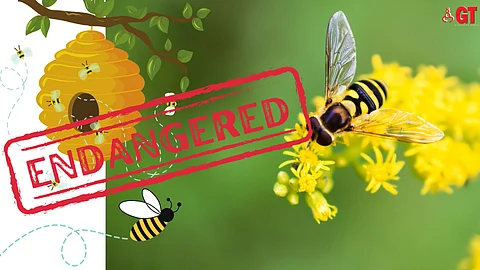Bees are disappearing in Goa, and you'll never guess why!
The decline in the bee population in Goa, especially stingless bees, can be attributed to burning weeds, pesticides and the false perception that bees pose a threat to human beings, according to ex-Deputy Director of Agriculture, Vitthal Joshi.
Joshi raised the alarm and appealed to the people of Goa not to kill bees, and destroy their hives out of ignorance and the superstitious belief that they bring bad luck.
He was speaking at a recent workshop, titled ‘Beekeeping Educational Workshop’, in Pilerne, North Goa.
“Many people believe that the cracks in the walls of their houses are caused by bees who make their hives within those crevices, and assume that the bees bring bad luck to the homeowners. However, this is a structural fault of the building, and not the bees,” stated Joshi.
Joshi’s workshop, conducted at the Goa State Pollution Control Board (GSPCB) in Pilerne, is a part of the month-long Greener Side Campaign, an initiative by Echoes of Earth, India’s greenest festival, that aims to shine the spotlight on the Western Ghats, and raise awareness about the importance of conserving Goa’s rich biodiversity.
“Bees are one of the most efficient pollinators across the insect kingdom and are of paramount importance to the health of the Western Ghats region and Goa’s biodiversity,” stated Joshi.
“Human activity is putting extreme pressure on bees, and hence, the urgent need to protect them arises,” he added.
Joshi posits that even while harvesting honey, care needs to be taken to leave a portion of the hive for the bees to make the process sustainable.
“I vouch for the domestication of wild local bees, instead of bringing in foreign variants that interfere with the local flora and fauna,” he shared.
“Those involved in apiculture need to ensure that they harvest honey between September and October, and February and March, as there is a period for the bees to collect nectar when flowers are in full bloom during these months. This will prevent the bees from starvation,” he said.
Joshi also said that there is a lacuna in the Goan market for honey and rearing stingless bees, which creates a peculiar honey with medicinal properties that is worth Rs 5,000 and above for one kilogram.
This is a lucrative opportunity for Goan entrepreneurs that would simultaneously translate into the bees’ conservation.
“As stingless bees are very tiny and have a limited honey collection range, they can be reared among certain plants to get particular flavours of honey, including the rare blooms of the once-in-eight-years karvi flower honey that has anti-carcinogenic properties,” he shared.
“The state of Gujarat is already commercialising this method of creating selective honey flavours as there is a massive international demand for this type of honey. Goa’s foray into honey production is practically negligible, but there is scope to catch up,” said Joshi.
Goa Chapter Head of the National Restaurant Association of India (NRAI), Prahlad Sukhtankar stated that the restaurant industry could also help raise awareness about the importance of bee conservation by educating customers through menu descriptions of the local kinds of honey utilised in dishes.
“The restaurant industry can help enhance local bee conservation efforts by supporting local apiaries to forge a deeper connection between the industry and regional agriculture,” said Sukhtankar.

